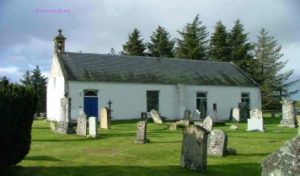Kincardine Church
Although plain and simple, Kincardine is of considerable historic interest. Though the patron saints of many of our neighbouring parishes were the famous Gaelic monks from Ireland – Columba, Moluag, Kenneth – Kincardine’s Tomhaldaich was of unique local importance: no other dedications to him exist anywhere else in the world.
Visitors to the Kirk will note the hollowed-out granite block by the front door. One of a series across northern Scotland, this is thought to have been a font used at the time of conversion to Christianity and may predate any building on the site.
There has been a church on this site since the 12th Century and the narrow ‘Lepers Squint’ window indicates that the current walls were built prior to the Reformation. This window allowed those suffering from leprosy who would otherwise have been excluded from the body of the church to watch the taking of the Sacrament. The iron frame on the wall is a mortsafe – a relic of the times of Grave robbing at the end of the 18th century.
Kincardine’s history has not always been so calm and peaceful as its location. Towards the end of the 15th Century Grants took revenge on their arch enemies/neighbours for the murder of their clan chief. Fleeing Comyns took refuge in the church as a place of sanctuary but a flaming arrow fired from outside set the roof on fire and with it those sheltering inside.
The granite gravestone in the kirkyard is relatively new but is dedicated to Walter Stewart –
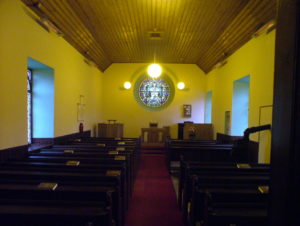 Kincardine has been served in part by a “missionary minister” based in Abernethy or Duthil and in part by its own Minister living in the Manse which was sold in the 1950s as it was proving very difficult to find an incumbent. Its interior is relatively plain but the War Memorial on the left-hand wall shows just how widely drawn its congregation was –
Kincardine has been served in part by a “missionary minister” based in Abernethy or Duthil and in part by its own Minister living in the Manse which was sold in the 1950s as it was proving very difficult to find an incumbent. Its interior is relatively plain but the War Memorial on the left-hand wall shows just how widely drawn its congregation was –
The wonderful gnarled old tree by the entrance to the graveyard is a dwarf elder – a tree common in Lochaber but not here. On her deathbed the wife of the 5th Baron – a Cameron – wanted to be buried in the soil of her beloved Lochaber. Soil containing the seeds of this dwarf elder was therefore brought from her homeland for this purpose and the tree has been here ever since.
If you choose to visit please stop awhile, enjoy the tranquility and sign the Visitors Book.
The parishes are now linked with the parish of Abernethy under the guidance of our minister, Rev Graham Atkinson.
Kincardine Church was placed on the market during the summer of 2023 and has now passed into the hands of the Kincardine Church Trust – a family trust based on the surrounding east Pityoulish Estate. For further information please click here
St Columba’s, Boat of Garten
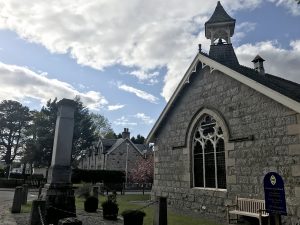
Some 20 years previously in 1865 Boat of Garten had come into being as a village as a result of the building of the Railway Station which lay on the rail line between Blair Atholl and Forres and also of the accommodation necessary for those who would service that railway, As part of that growth a post office, a hotel and a merchant’s shop were established. In the intervening period up to 1881 Church services were held variously in the local school and in the waiting room of the Station with the Minister from Duthil Old Kirk officiating –
Duthil Kirk Session Minutes record a meeting, probably held in the Boat Hotel, attended by the Rev James Bain, Duthil Minister, the Missionary Minister, the Postmaster, the Stationmaster, the Hotel Keeper and representatives from Duthil. At the meeting it was agreed that an approach be made to Seafield Estates for a piece of land on which to build a church. This was duly done –
Boat of Garten and Kincardine became a parish in its own right in January 1932 necessitating the purchase of a Manse. The Church itself was extended by the building of its Church Hall and Chancel in 1936.
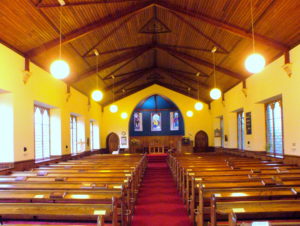 In more recent years there have been a number of changes most notably the creation of a Linked Charge (subsequently United Charge) with Duthil Church (since 2017 known as Carrbridge Church) with the Minister resident in the Manse in Boat of Garten. Thereafter there came the creation of linkage of a similar nature with Abernethy (Nethybridge) Church.
In more recent years there have been a number of changes most notably the creation of a Linked Charge (subsequently United Charge) with Duthil Church (since 2017 known as Carrbridge Church) with the Minister resident in the Manse in Boat of Garten. Thereafter there came the creation of linkage of a similar nature with Abernethy (Nethybridge) Church.
In 2013 we welcomed our new Minister Rev Donald Walker, who has since retired. On the 30th October 2019 the new Minister for both parishes, the Rev Graham Atkinson, will be inducted.
Duthil Old Parish Church & Carrbridge Church
A Tale of 2 Churches – Duthil Old Parish Church (now disused) and Duthil/Carrbridge Church (situated within the village)
The first recorded church at Duthil, dedicated to St Peter, was built about 1400, probably on the site of an earlier building. The church has been rebuilt on several occasions. The New Statistical Account reports the pre-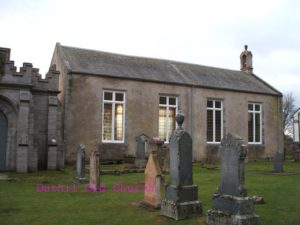 alls, and off the north wall, sloped down towards the pulpit, and the ground floor seating was also arranged facing the pulpit and to each side. At the same time the Seafield burial vault under the previous church was replaced by the self standing first Mausoleum.The church was again renovated just before World War I by the Glasgow architect Peter MacGregor Chalmers, when the intention was to provide space for an organ and choir. Old Duthil Church closed for services in 1967.
alls, and off the north wall, sloped down towards the pulpit, and the ground floor seating was also arranged facing the pulpit and to each side. At the same time the Seafield burial vault under the previous church was replaced by the self standing first Mausoleum.The church was again renovated just before World War I by the Glasgow architect Peter MacGregor Chalmers, when the intention was to provide space for an organ and choir. Old Duthil Church closed for services in 1967.
When the building was closed and sold, its pulpit and Communion table and chair were removed and re-
Outside the Church there is an interesting, possibly pre –
Carrbridge Church is the church in current usage for the Parish. Opened in August, 1909. In 1976 it underwent a transformation with the completion of an extensive renovation scheme costing £7,609.It included the remodelling of the chancel to house the pulpit, Communion table and chair, from the disused Old Parish Church at Duthil. The Communion table is in memory of the Rev Patrick Grant, minister of Duthil in the late 18th and early 19th Centuries. From him were descended through his daughter, a number of distinguished people who are commemorated by Duthil memorial tablets. They include Field Marshall Sir Patrick Grant and General Sir Henry Fane Grant.
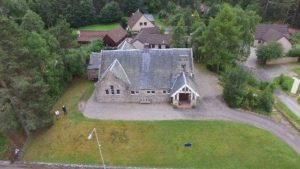
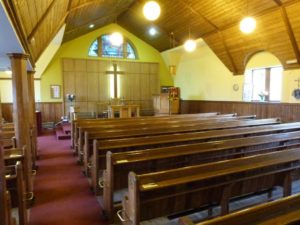
These tablets were “rescued” and placed in the Duthil Chapel –
The renovated church was dedicated by the Rev Dr Horace Walker, Secretary of the Church of Scotland Home Board. The Congregation is very active in its outreach and focused on spreading the Gospel to all its constituents.

